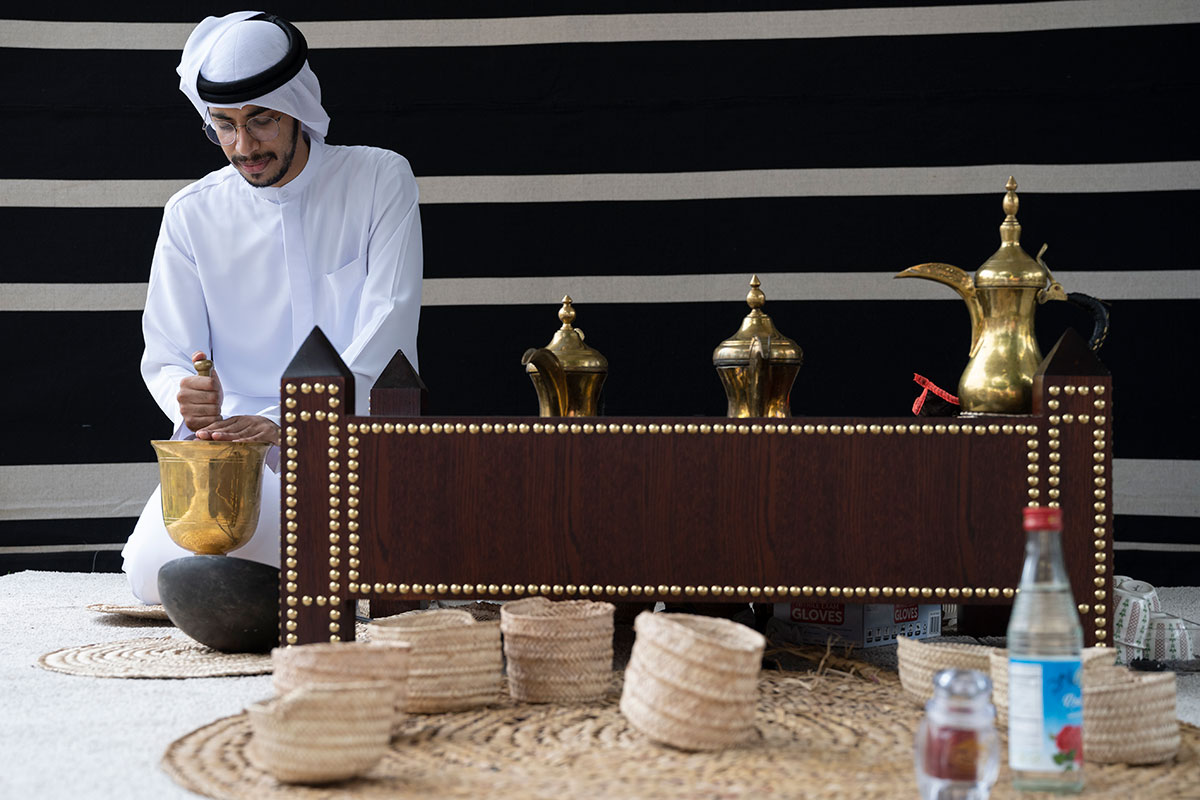[ad_1]

Ahmed Al Shimmari prepares conventional Arabic espresso on the 2022 Smithsonian Folklife Competition.
Picture by Yijo Shen, Ralph Rinzler Folklife Archives
Within the United Arab Emirates, the clinking of pestle towards mortar alerts recent gahwa, or conventional Arabic espresso, and anybody within the neighborhood is welcome to hitch.
“Being hospitable doesn’t imply that it’s a must to do one thing massive,” Ahmed Al Shimmari says. “A small factor like a cup of gahwa can carry collectively so many individuals.”
I met Al Shimmari on the Smithsonian Folklife Competition, the place he and a staff of consultants from the UAE demonstrated the preparation of Arabic coffee and supplied hourly tastings to guests. As he struck the pestle towards the brass wall of the mortar, he invited flocks of individuals to the Espresso tent. He started every demonstration this fashion, fastidiously calculating how a lot gahwa he wanted to serve every inquisitive viewers member.
As observers craned their necks to look into the ornately engraved manhaz and rashad—conventional Arabic mortar and pestle—one other participant defined how gahwa is deeply tied to Emirati hospitality and meals tradition. Ahmed Al Shimmari, Mariam Al Dhaheri, and Bashair Al Balooshi walked us via what gahwa means to them and the way it brings collectively communities, even throughout oceans on the Competition.
I watched how Al Shimmari made gahwa and was fortunate sufficient to sip the espresso whereas I conversed with him and his staff. Gahwa is ready otherwise all through the Center East, he defined, nevertheless it shares the identical cultural which means as “the welcoming drink.”
The primary step is roasting the beans utilizing the tawa, a rounded pot sometimes made of iron, and mehmas, a flat paddle used to combine the beans. To my shock, the espresso beans seem inexperienced earlier than getting toasted, permitting them to darken.
Al Shimmari then takes out three dallahs, conventional espresso pots that every serve a special function based on its measurement. The largest pot, known as khamara, boils water whereas the beans roast. After the beans attain a light-weight roast, which permits for the citrus notes to return out, he cools them down by tossing the beans up and down within the mebrada, a wicker internet. As guests’ eyes comply with the undulating movement, Al Shimmari’s eyes scan the beans for the misshapen ones. He picks out the oddly formed beans, guaranteeing homogeneity, to extract the perfect taste profile.

Picture by Yijo Shen, Ralph Rinzler Folklife Archives

Picture by Yijo Shen, Ralph Rinzler Folklife Archives

Picture by Yijo Shen, Ralph Rinzler Folklife Archives

Picture by Mark C. Younger, Ralph Rinzler Folklife Archives
Al Shimmari then locations the beans into the mortar and, with the pestle, grinds them right into a powder. The boiled water and occasional grounds then steep within the second largest dallah, the khamra. Al Shimmari sprinkles in floor cardamom and saffron, permitting them to infuse the gahwa with their wealthy flavors. Whereas spicing gahwa is dependent upon the area, it will also be loved plain.
After a couple of minutes, Al Shimmari locations a filter, made out of palm tree fibers, over the spout of the dallah. He pours the combination into the ultimate and smallest dallah, the mezalah, which is used to serve. It’s correct etiquette for the muqahwi, the individual serving, to strive the gahwa earlier than handing it to their friends. Al Shimmari pours a small quantity right into a fenjan, a small consuming cup.
Glad, Al Shimmari would begin serving the viewers, passing out paper cups to keen fingers. My cup was fragrant and bitter with the distinct taste of saffron. The sharpness could be softened with the sweetness of dried dates, or tamer.
Al Shimmari discovered gahwa traditions from his mother and father, as most individuals do, though there are additionally gahwa coaching facilities, a testomony to its cultural significance within the Center East. Al Dhaheri is this system unit head at Bait Al Gahwa, a coaching middle in Abu Dhabi. It’s important to know why gahwa is vital in Arab tradition, she defined, emphasizing that it should be ready in the identical means from era to era. And not using a agency understanding of all points of the custom, it could actually slowly fade.
This philosophy of conserving and sharing a timeless custom is translated throughout the Atlantic Ocean to Washington, D.C. Because the viewers flocked across the tent, desperate to ask questions and to take a better have a look at the delicately engraved brass, Al Shimmari reiterated the distinction between Arab reverence for espresso and the American grab-and-go espresso tradition. For many individuals throughout the Arabian Peninsula, espresso symbolizes group, friendship, and hospitality. Al Shimmari instructed me that espresso is taken into account much more vital than meals when it involves Arabic hospitality etiquette. In the US, espresso is one thing consumed on the go through the morning rush, as a fast pick-me-up in the afternoon, or as a late-night caffeine repair for night time owls. Espresso is vital in each cultures, however the ways in which we assemble life round this drink are vastly totally different.
All three members reiterated that they discovered pleasure in sharing their tradition and realizing that individuals are genuinely curious to be taught extra about Emirati heritage. They opened their arms to anybody who got here beneath the tent and, simply as within the UAE, have been keen to share a fenjan of gahwa with them, hoping to spark dialog and create cultural understanding.

Picture by Sonya Pencheva, Ralph Rinzler Folklife Archives
Mioko Ueshima is a Katzenberger intern on the Smithsonian Middle for Folklife and Cultural Heritage and a rising junior at Georgetown College majoring in American research with a minor in Japanese.
[ad_2]
Source link


